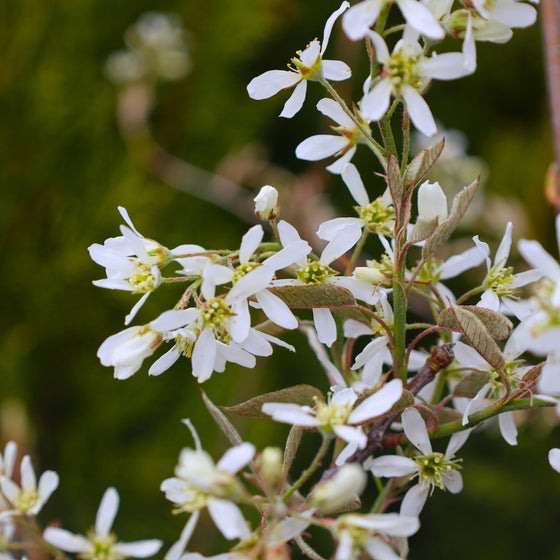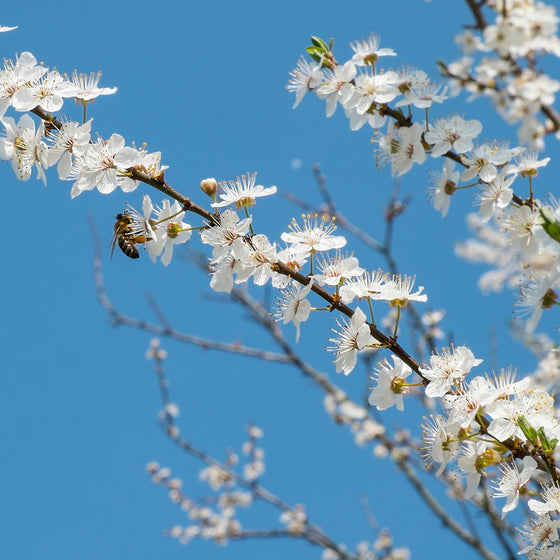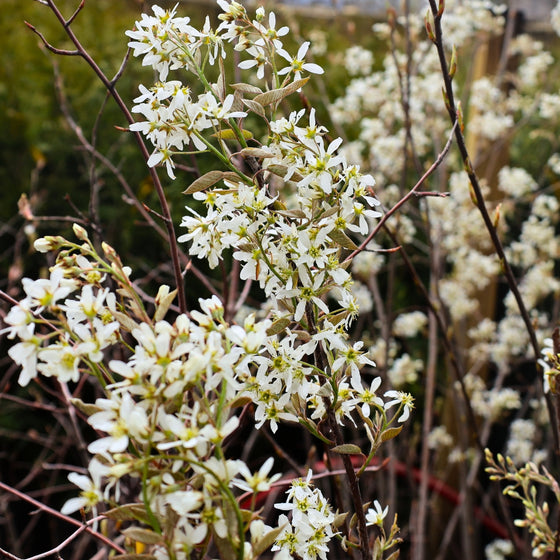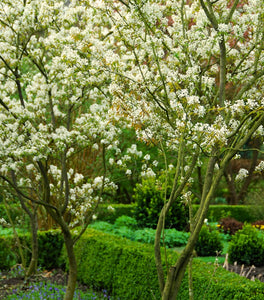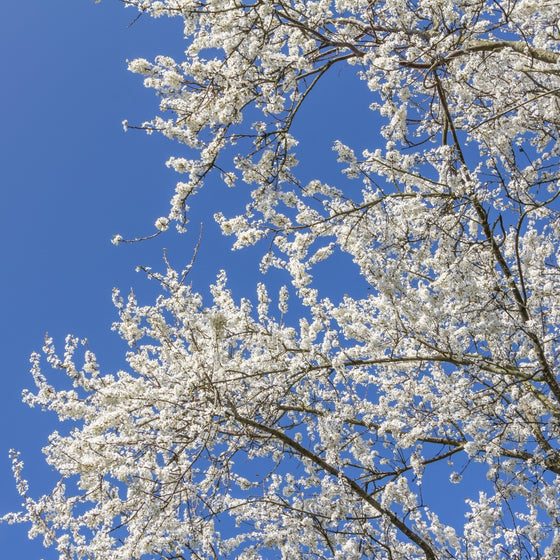
Images Depict Mature Plants
Allegheny Serviceberry Trees
Add four-season beauty and native charm to your landscape with the Allegheny Serviceberry (Amelanchier laevis), a graceful small tree or large multi-stemmed shrub prized for its year-round ornamental appeal and wildlife value. In early spring, this North American native bursts into bloom with delicate, white, star-shaped flowers that cover the branches before the leaves emerge, attracting early-season pollinators. As the flowers fade, smooth, bronze-tinged foliage appears and matures into lush green throughout summer, creating a soft, airy canopy perfect for borders, understory plantings, or naturalized gardens.
By early summer, the Allegheny Serviceberry produces small, blueberry-like fruits that are edible and sweet, attracting songbirds, squirrels, and other wildlife. These berries can also be enjoyed fresh or used in jams, pies, or preserves, adding both ornamental and culinary value to the garden. In autumn, the foliage transforms into a brilliant display of orange, red, and gold, providing vibrant fall color that rivals many non-native ornamentals. Its smooth, gray bark adds winter interest, making this tree a standout in every season.
Tolerant of a range of soil types and growing conditions, Allegheny Serviceberry prefers full sun to partial shade and moist, well-drained soil. It’s an excellent choice for native plant gardens, rain gardens, or as a specimen tree in residential landscapes. Its modest size—typically 15 to 25 feet tall—makes it suitable for smaller yards or urban environments where beauty, biodiversity, and ecological function are key. With its multi-season appeal, pollinator benefits, and wildlife value, Allegheny Serviceberry is a versatile native tree that brings both elegance and environmental impact to your outdoor space.

| Hardiness Zone: | 4-8 |
|---|---|
| Mature Height: | 20 to 25 Feet |
| Mature Width: | 15 to 20 Feet |
| Classification: | Tree Form Serviceberry |
| Sunlight: | Full Sun to partial shade |
| Habit: | Upright |
| Foliage: | Green |
| Flower Color: | White |
| Soil Condition: | Any well drained soil |
| Water Requirements: | Water well until established |
How to Care for Allegheny Serviceberry
Be sure to read our planting instructions to ensure a healthy and happy Allegheny Serviceberry plant for years to come!
How do I Plant My Allegheny Serviceberry Trees?
To plant your Allegheny Serviceberry tree (Amelanchier laevis), choose a location with full sun to partial shade and well-drained, slightly acidic soil rich in organic matter. Begin by digging a hole two to three times wider than the root ball and just as deep. Remove the tree from its container or burlap wrap, gently loosen the roots, and place it in the hole so that the top of the root ball is level with the surrounding soil. Backfill the hole with native soil, tamp down lightly to remove air pockets, and water thoroughly to help settle the roots. Space multiple serviceberry trees 15–20 feet apart if planting in a group or naturalized setting. After planting, apply a 2–3 inch layer of organic mulch around the base, keeping it a few inches away from the trunk to prevent rot and promote healthy airflow. Mulch helps retain soil moisture and regulate temperature, both of which are beneficial during the tree’s establishment period. Water regularly during the first growing season, especially during dry spells, to support root development. With proper planting and early care, your Allegheny Serviceberry will reward you with beautiful spring blossoms, edible summer fruit, and brilliant fall foliage, all while supporting pollinators and native wildlife in your landscape.
How do I Water My Allegheny Serviceberry Trees?
Watering your Allegheny Serviceberry tree properly is essential during the first one to two years after planting to ensure healthy establishment and vigorous growth. In its early stages, water deeply once or twice per week, depending on weather and soil conditions, aiming to keep the root zone consistently moist but never waterlogged. Use a slow, deep soak method to encourage deep root development—either with a drip system or by letting a hose trickle at the base for 20–30 minutes. A 2–3 inch mulch layer around the base helps retain moisture and protect roots from temperature fluctuations. Once established, Allegheny Serviceberry trees are moderately drought tolerant but will perform best with occasional watering during extended dry periods. Monitor soil moisture during hot summer months or when rainfall is scarce, especially if the tree is planted in full sun. Avoid overhead watering, which can lead to fungal issues on the leaves and fruit; instead, focus on watering at the base of the tree. Proper irrigation supports lush foliage, abundant berry production, and vibrant fall color—ensuring your Allegheny Serviceberry remains a thriving focal point in native landscapes, woodland edges, or wildlife-friendly gardens.
How do I Fertilize My Allegheny Serviceberry Trees?
Fertilizing your Allegheny Serviceberry tree helps support healthy growth, vibrant foliage, and abundant flowering and fruiting. In early spring, before new growth appears, apply a balanced slow-release fertilizer such as a 10-10-10 or 14-14-14 formula around the drip line of the tree, keeping the granules a few inches away from the trunk. For organic gardeners, compost, leaf mold, or well-aged manure can also provide a nutrient boost while improving soil structure. Water the area thoroughly after application to help nutrients reach the roots and reduce the risk of root burn. Young Allegheny Serviceberry trees benefit from annual feeding, but once established, they often thrive with just one spring application each year, especially when grown in rich, well-amended soil. Avoid over-fertilizing, particularly with high-nitrogen formulas, as this can promote excessive leafy growth at the expense of flowers and berries. For trees planted in nutrient-poor or sandy soils, a soil test can help determine specific nutrient needs. With proper fertilization, your Allegheny Serviceberry will deliver multi-season interest—delicate spring blooms, summer berries, and brilliant fall color—while supporting pollinators and birds in your landscape.

How and When Should I Prune My Allegheny Serviceberry Trees?
Pruning your Allegheny Serviceberry tree should be done in late winter to early spring, while the tree is still dormant and before new growth begins. Start by removing any dead, damaged, or diseased branches, as well as any crossing limbs that may rub and cause injury. Thin out crowded areas to improve air circulation and light penetration, which helps prevent fungal diseases and encourages healthy flowering and fruit production. Use clean, sharp pruning tools to make precise cuts just outside the branch collar to promote proper healing. For multi-stemmed specimens, you may also want to shape the plant by selectively thinning out a few of the older stems every few years to encourage new, vigorous growth. If growing your Allegheny Serviceberry as a single-stem tree, maintain a central leader by removing competing upright branches. Avoid heavy pruning during the growing season, as this can reduce the number of spring blooms and summer berries. With proper and timely pruning, your Allegheny Serviceberry will maintain an elegant form, produce reliable seasonal interest, and support pollinators and birds in native and ornamental landscapes.

